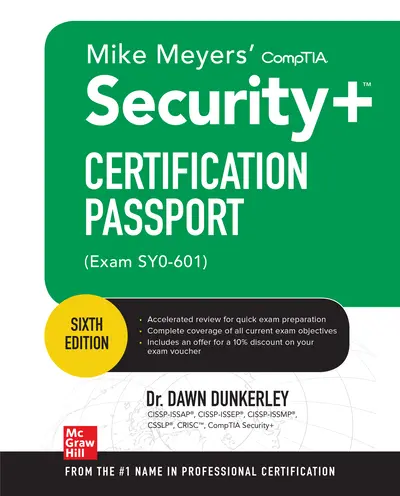My Account Details

ISBN10: 1260467953 | ISBN13: 9781260467956

Step 1 . Download Adobe Digital Editions to your PC or Mac desktop/laptop.
Step 2. Register and authorize your Adobe ID (optional). To access your eBook on multiple devices, first create an Adobe ID at account.adobe.com. Then, open Adobe Digital Editions, go to the Help menu, and select "Authorize Computer" to link your Adobe ID.
Step 3. Open Your eBook. Use Adobe Digital Editions to open the file. If the eBook doesn’t open, contact customer service for assistance.
This quick review, cram-style study guide offers 100% coverage of every topic on the latest version of the CompTIA Security+ exam
Get on the fast track to becoming CompTIA Security+ certified with this affordable, portable study tool. Inside, cybersecurity experts guide you on your exam preparation path, providing insightful tips and sound advice along the way. With an intensive focus on only what you need to know to pass the CompTIA Security+ Exam SY0-601, this certification passport is your ticket to success on exam day.
TECHNICAL BULLETS:
Inside:
- Practice questions and content review after each objective prepare you for exam mastery
- Exam Tips identify critical content to prepare for
- Updated information on real-world cyberattacks
- Enhanced coverage of emerging topics, such as Internet of Things (IoT) and cloud security
Covers all exam topics, including how to:
- Understand attacks, threats, and vulnerabilities
- Assess the security posture of an enterprise environment
- Recommend and implement appropriate security solutions
- Monitor and secure hybrid environments, including cloud, mobile, and IoT
- Operate with an awareness of applicable laws and policies, including the principles of governance, risk, and compliance
- Identify, analyze, and respond to security events and incidents
Online content includes:
- 200 practice exam questions
1.1 Compare and contrast different types of social engineering techniques
1.2 Given a scenario, analyze potential indicators to determine the type of attack
1.3 Given a scenario, analyze potential indicators associated with application attacks
1.4 Given a scenario, analyze potential indicators associated with network attacks
1.5 Explain different threat actors, vectors, and intelligence sources
1.6 Threat Awareness and Mitigation
1.7 Summarize the techniques used in security assessments
1.8 Explain the techniques used in penetration testing
Domain 5 Governance, Risk, and Compliance
5.1 Compare and contrast various types of controls
5.2 Explain the importance of applicable regulations, standards, or frameworks that impact organizations
5.3 Explain the importance of policies to organizational security
5.4 Summarize risk management processes and concepts
5.5 Explain privacy and sensitive data concepts in relation to security
Domain 2 Architecture and Design
2.1 Explain the importance of security concepts in an enterprise environment
2.2 Summarize virtualization and cloud computing concepts
2.3 Summarize secure application development, deployment, and automation concepts
2.4 Summarize authentication and authorization design concepts
2.5 Given a scenario, implement cybersecurity resilience
2.6 Explain the security implications of embedded and specialized systems
2.7 Explain the importance of physical security controls
2.8 Summarize the basics of cryptographic concepts
Domain 3 Implementation
3.1 Given a scenario, implement secure protocols
3.2 Given a scenario, implement host or application security solutions
3.3 Given a scenario, implement secure network designs
3.4 Given a scenario, install and configure wireless security settings
3.5 Given a scenario, implement secure mobile solutions
3.6 Given a scenario, apply cybersecurity solutions to the cloud
3.7 Given a scenario, implement identity and account management controls
3.8 Given a scenario, implement authentication and authorization solutions
3.9 Given a scenario, implement public key infrastructure
Domain 4 Operations and Incident Response
4.1 Given a scenario, use the appropriate tool to assess organizational security
4.2 Summarize the importance of policies, processes, and procedures for incident response
4.3 Given an incident, utilize appropriate data sources to support an investigation
4.4 Given an incident, apply mitigation techniques or controls to secure an environment
4.5 Explain the key aspects of digital forensics
Need support? We're here to help - Get real-world support and resources every step of the way.